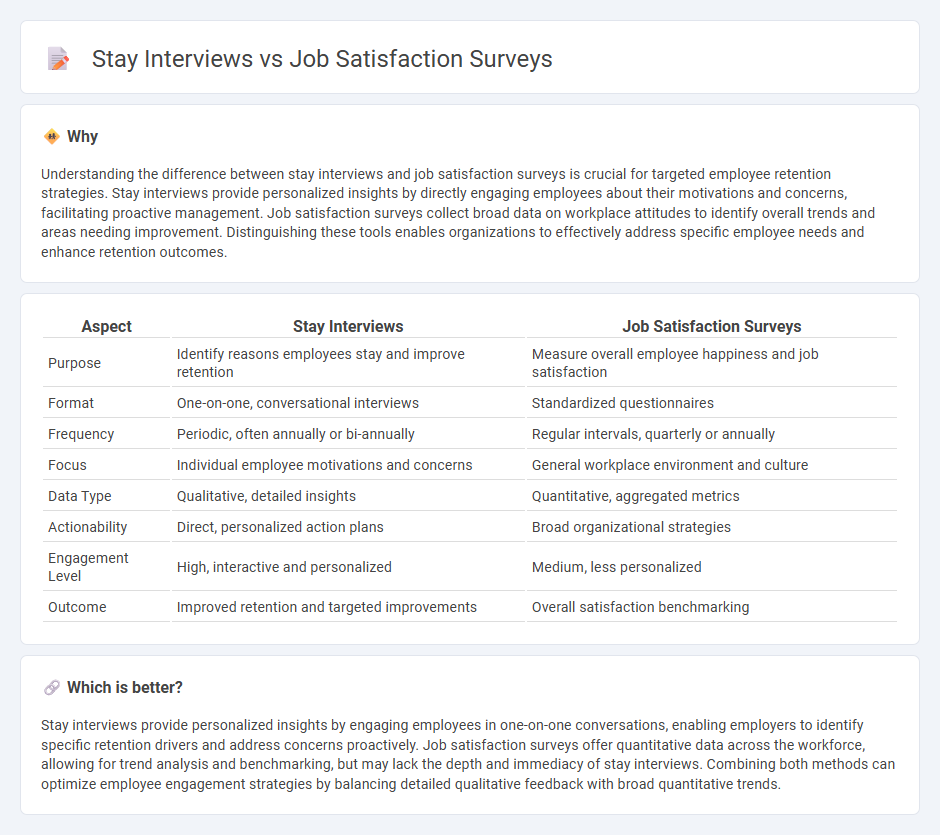
Stay interviews provide personalized, real-time insights into employee motivations and concerns by engaging individuals directly, while job satisfaction surveys collect comprehensive data on workforce sentiment through structured questionnaires. These methods serve complementary roles in enhancing retention strategies and improving workplace culture. Explore how combining both approaches can optimize employee engagement and reduce turnover.
Why it is important
Understanding the difference between stay interviews and job satisfaction surveys is crucial for targeted employee retention strategies. Stay interviews provide personalized insights by directly engaging employees about their motivations and concerns, facilitating proactive management. Job satisfaction surveys collect broad data on workplace attitudes to identify overall trends and areas needing improvement. Distinguishing these tools enables organizations to effectively address specific employee needs and enhance retention outcomes.
Comparison Table
| Aspect | Stay Interviews | Job Satisfaction Surveys |
|---|---|---|
| Purpose | Identify reasons employees stay and improve retention | Measure overall employee happiness and job satisfaction |
| Format | One-on-one, conversational interviews | Standardized questionnaires |
| Frequency | Periodic, often annually or bi-annually | Regular intervals, quarterly or annually |
| Focus | Individual employee motivations and concerns | General workplace environment and culture |
| Data Type | Qualitative, detailed insights | Quantitative, aggregated metrics |
| Actionability | Direct, personalized action plans | Broad organizational strategies |
| Engagement Level | High, interactive and personalized | Medium, less personalized |
| Outcome | Improved retention and targeted improvements | Overall satisfaction benchmarking |
Which is better?
Stay interviews provide personalized insights by engaging employees in one-on-one conversations, enabling employers to identify specific retention drivers and address concerns proactively. Job satisfaction surveys offer quantitative data across the workforce, allowing for trend analysis and benchmarking, but may lack the depth and immediacy of stay interviews. Combining both methods can optimize employee engagement strategies by balancing detailed qualitative feedback with broad quantitative trends.
Connection
Stay interviews provide real-time insights into employee motivations and concerns, complementing job satisfaction surveys that measure overall workplace contentment. Combining data from both tools enables organizations to identify specific factors influencing retention and engagement, leading to targeted improvements. This integrated approach enhances talent management strategies by addressing issues before they escalate into turnover risks.
Key Terms
Employee Engagement
Job satisfaction surveys collect broad quantitative data on employee feelings about roles, benefits, and workplace culture, providing insights across the organization. Stay interviews involve direct, qualitative conversations between managers and employees to uncover specific factors that influence retention and engagement. Explore detailed strategies to enhance employee engagement by leveraging both tools effectively.
Retention
Job satisfaction surveys provide quantitative data on employee contentment and workplace factors impacting retention, while stay interviews offer qualitative, personalized insights into individual employee motivations and concerns. Both tools enhance retention strategies by identifying issues early and fostering open communication, yet stay interviews are more effective for real-time feedback and relationship building. Explore how integrating both approaches can strengthen your retention efforts.
Feedback Mechanisms
Job satisfaction surveys collect quantitative data on employee experiences through standardized questions, enabling organizations to identify patterns and trends over time. Stay interviews involve one-on-one conversations that provide qualitative insights into individual motivations and concerns, fostering personalized feedback and proactive retention strategies. Explore how integrating both mechanisms can enhance your company's employee engagement and retention efforts.
Source and External Links
Employee Satisfaction Survey: Questions, Tips, Examples - Surveys effectively measure employee satisfaction by collecting both quantitative ratings and qualitative feedback, with repeated surveys tracking changes over time and interviews providing deeper insights into survey results.
Job Satisfaction Survey (JSS) - Statistics Solutions - The Job Satisfaction Survey (JSS) is a validated questionnaire by Paul E. Spector that assesses nine dimensions of job satisfaction using 36 items rated from "strongly disagree" to "strongly agree."
45 Sample Questions for Employee Satisfaction Surveys - HRMorning - Employee satisfaction surveys gather data on employee contentment with topics like company culture, compensation, career growth, and management performance, helping organizations boost engagement and reduce turnover.
 dowidth.com
dowidth.com